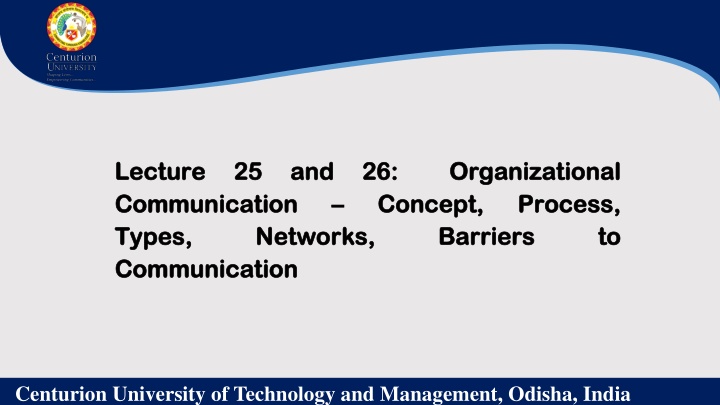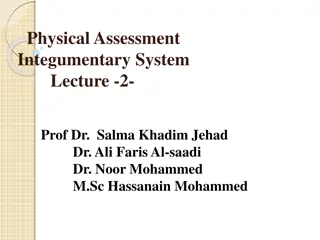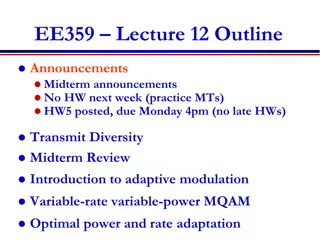
Key Aspects of Organizational Communication for Workplace Success
Explore the types of organizational communication including formal, informal, horizontal, and vertical communication at Centurion University of Technology and Management. Discover how effective organizational communication impacts employee engagement, collaboration, and workplace success by promoting a positive employee experience, alignment with company values, and streamlined information flow.
Download Presentation

Please find below an Image/Link to download the presentation.
The content on the website is provided AS IS for your information and personal use only. It may not be sold, licensed, or shared on other websites without obtaining consent from the author. If you encounter any issues during the download, it is possible that the publisher has removed the file from their server.
You are allowed to download the files provided on this website for personal or commercial use, subject to the condition that they are used lawfully. All files are the property of their respective owners.
The content on the website is provided AS IS for your information and personal use only. It may not be sold, licensed, or shared on other websites without obtaining consent from the author.
E N D
Presentation Transcript
Lecture Lecture Communication Communication Types, Types, Communication Communication 25 25 and and 26 26: : Concept, Concept, Organizational Organizational Process, Process, Barriers Barriers Networks, Networks, to to Centurion University of Technology and Management, Odisha, India
Organizational communication is one of the essential prerequisites for building a successful business. Its impact on employee engagement, collaboration, and workplace trust and employee experience makes it an important part of every workplace strategy. 1. Formal communication Being formal, clear and specific is a great way to ensure a proper flow of information in the workplace. With formal communication, everyone is informed about and aligned with the business goals. 2. Informal communication As you might have guessed, this type of communication is the opposite of formal communication. It is also known as grapevine communication . In essence, it includes dialogues, chats, phone conversations as well as the water cooler talks that usually take place near the coffee maker that don t rely on any formalities. Centurion University of Technology and Management, Odisha, India
3. Horizontal communication This type of organizational communication occurs amongst teams, groups, or individuals at the same hierarchical level. Horizontal communication plays an important role in breaking down silos and improving cross-departmental collaboration in the workplace. It plays a critical role in aligning tech, marketing and sales teams and making sure that everyone is on the same page. 4. Vertical communication The most common form of communication within structured organizations follows an up- and- down vertical pattern. It includes communication between business leaders, team leaders and employees. This type of communication is essential in the workplace. Without vertical communication, it wouldn t be possible to share guidelines, feedback, or ideas. Centurion University of Technology and Management, Odisha, India
Effective organizational communication impacts organizational success in many ways. Some of them include: Creating a positive employee experience increases employee morale, satisfaction and engagement. Helping employees understand the terms and conditions of their employment and driving their commitment and loyalty. Encouraging employees share of voice significantly improves employees satisfaction with their employer. Helping to decrease misunderstandings and the spread of misinformation in the workplace. Improving cross-departmental communication and collaboration among employees Centurion University of Technology and Management, Odisha, India
Helping employees align with the companys mission, vision and core values. Driving higher employees engagement by keeping employees informed at all times. Making it easy for employees to find important and relevant information whenever they need it. Streamlining the flow of information within the organization. Improving employee productivity by eliminating waste of time spent on information search and communication on irrelevant topics. Improving processes and procedures and ultimately creating greater efficiencies and cost reductions. Building better relationships between employees and their managers. Improving trust in the workplace. Making communication more fun. Improving communication with non-wired, remote and deskless employees. Centurion University of Technology and Management, Odisha, India
Communication Networks: 1. Vertical Network: The communication which passes from one person or process to another person or process in a vertical pattern is called Vertical Network. It can happen either in the top to bottom or bottom to top format. This communication provides an immediate response as the receiver receives the information faster than any other network. We can call this network as a formal network. The best example is the communication between top level and bottom level employees. Miscommunication does not happen in this network as this is a type of direct communication. Centurion University of Technology and Management, Odisha, India
2. Chain Network: This network is in a hierarchical level and follows a series of commands. Here bottom to top communication does not happen. Superiors ordering the subordinates is the best example of this type of network. Also, the leader leading the group of people is an example of Chain Network. The message has to reach from top-level to bottom level without any alteration of meaning or words. Care should be taken to avoid the same. This network is not fast and few people who don t understand the message will remain in the loop. 3. Circuit Network: When the communication between two people happens simultaneously in a circuit is called Circuit Network. Though it works like Vertical Network, there are no superiors or subordinates or at least not considered like them. Here the communication is a two-way communication. The messaging or information reception is continuous and the people involved can be at the same hierarchical level. Centurion University of Technology and Management, Odisha, India
4. Wheel or Spoke Network: The commands or information is from a single superior and subordinates form a wheel in the network. The entire network is highly centralized format and expects immediate feedback once the message is given to the receiver. And due to this, we can call this communication as a type of micromanagement. This network is an improved form of Chain Network. Since the information is received directly from the central authority, there is no chance of miscommunication and the communication is very powerful. Startups mostly use this type of network. 5. Star Network: Several people are involved in this network and the process forms a star shape. This network enables people to communicate with each other or with people who are involved in the same process. This network can be considered as a development of a wheel network with no central person to control the way of communication. All are free to communicate with each other. No restrictions are present to block the communication between people in the process. Teamwork is built using this communication. A WhatsApp group which is related to work is a good example of Star Network. Centurion University of Technology and Management, Odisha, India
Barriers of Communication: Semantic Barriers Psychological Barriers Organisational Barriers Personal Barriers 1. Semantic Barriers The branch of science that deals with the meaning of words and sentences is known as Semantic. The problems and obstructions in the process of encoding and decoding message into words or impressions is known as Semantic barriers. This barrier arises because different words mean different things to different people. A breakdown in communication can occur when two individuals attach different meanings to a word. For example, for organisations, Profits may mean growth and efficiency, but for employees, it may mean excess funds generated by paying inadequate wages and benefits. Centurion University of Technology and Management, Odisha, India
Some of the common forms of Semantic Barriers are as follows: Badly Expressed Message: When a message lacks clarity and precision, it is said to be a badly expressed message. Communication becomes ineffective when the language of the message is vague, imprecise, or there is the use of wrong words or omission of needed words. Symbols with Different Meanings: The same words may carry different meanings to different people, and can convey different meanings under different situations. For example, words like effect and affect, ideal and idle, advice and advice, bear and bare, etc., sounds similar, but they have different meanings. Centurion University of Technology and Management, Odisha, India
Faulty Translations: Sometimes, people do not understand the language in which a message is given by the sender. In such cases, it becomes necessary to translate the message into a language, which is understandable by the receiver. The translator should be proficient enough to translate the language, otherwise, this can also be a barrier to communication. Unclarified Assumptions: The receiver may have different assumptions if the sender does not clarify the assumptions about the message. For example, a boss may say, Complete the work . Here, the boss has not mentioned the day and date when the work has to be completed. He may mean to complete the work by tomorrow, but subordinates may understand it as a week s target. Technical Jargon: Technical Jargon or terminology are used by many experts and specialists to communicate messages. Such jargon is not understood by the common people, which leads to poor communication. Centurion University of Technology and Management, Odisha, India
Body Language and Gesture Decoding: Non-verbal or gestural communication is also an effective means of communication. Facial expressions, gestures, body language, etc., should correspond to the language. The receiver may get confused and can misunderstand the message if verbal language does not match the body language. 2. Psychological Barriers Barriers which arise on the account of emotional and psychological status of the sender and receiver of the message are known as Psychological Barriers. For example, a person who is under stress cannot communicate properly. Centurion University of Technology and Management, Odisha, India
Premature Evaluation: The tendency of forming a judgement before listening to the entire message is known as premature evaluation. This distorts understanding and acts as a barrier to effective communication. This can also lead to prejudices against communication. Lack of Attention: Communication can be less effective, and the message can be misunderstood if proper attention is not given to it. This inattention may arise due to the preoccupied mind of the receiver. For example, a superior gave instructions to operate a new software, however, the subordinate was preoccupied with other personal issues. Such lack of attention makes the communication process one-way and ineffective. Centurion University of Technology and Management, Odisha, India
Loss by Transmission and Poor Retention: There is loss of or transmission of inaccurate information when communication passes through various levels or channels in the organisation. It is more common in the case of oral communication. Poor retention also acts as a barrier when people are unable to retain the information for a long time. Distrust: Lack of mutual trust between the sender and the receiver also acts as a barrier to communication. Parties involved in communication cannot understand the message in an original sense when they do not believe each other. Centurion University of Technology and Management, Odisha, India
Organisational Barriers In an organisation, communication has to pass through various levels and channels, hence it may not reach the same place as it was sent by the sender. Organisation structure, rules and regulations, authority relationships, etc., act as a barrier to effective communication. Some of the Organisational Barriers are as follows: Organisational Policy: Effectiveness of communication is affected by organisational policy. The communication process is hampered if the policy is not supportive of the free flow of communication. For example, in a centralised organisation, free communication is not encouraged, and communication has to follow through a proper channel only. Centurion University of Technology and Management, Odisha, India
Rules and Regulations: The process of communication is affected by rigid and cumbersome rules and regulations. The channels and the subject matter are already prescribed through, which the messages are to be communicated. These prescribed rules, regulations, and channels are rigid and can act as barriers. Status: Psychological distance is created between superior and subordinate because of status. Such statuses stand in the way of true and accurate communication. Subordinates are also not allowed to express their feeling freely if the manager is status conscious. Centurion University of Technology and Management, Odisha, India
Complexity in Organisation Structure: Organisation structure can also act as a barrier to communication. If there are many managerial levels in an organisational structure, then communication gets delayed and distorted. Organisational Facilities: If facilities like frequent meetings, conferences, suggestion boxes, complaint boxes, etc., are absent in an organisation, then effective communication is hampered. Centurion University of Technology and Management, Odisha, India
Personal Barriers The effectiveness of communication is influenced by the personal factors of both sender and the receiver. Some of the Personal Barriers are as follows: Fear of Challenge to Authority: If a superior fears that a particular communication can hamper his authority, then he may withhold such communication, as he always wants to maintain a higher position and prestige in the organisation. Lack of Confidence of Superior on his Subordinates: When superiors do not have faith or confidence on the competence of their subordinates, then communication is said to be hampered. When there is a lack of trust and confidence in subordinates, the superior may not take advice or suggestions from the subordinates. Centurion University of Technology and Management, Odisha, India
Unwillingness to Communicate: Unwillingness to communicate can be another reason for ineffective communication. Many times, subordinates do not communicate with their superiors because they believe that if the information is not correct or appropriate, it will adversely affect them. Lack of Proper Incentives: Subordinates also do not take initiative to communicate, when there is no motivation or incentives for communication. For example, if there is no reward for the suggestion given by the subordinates, then they will not take initiative. Centurion University of Technology and Management, Odisha, India











